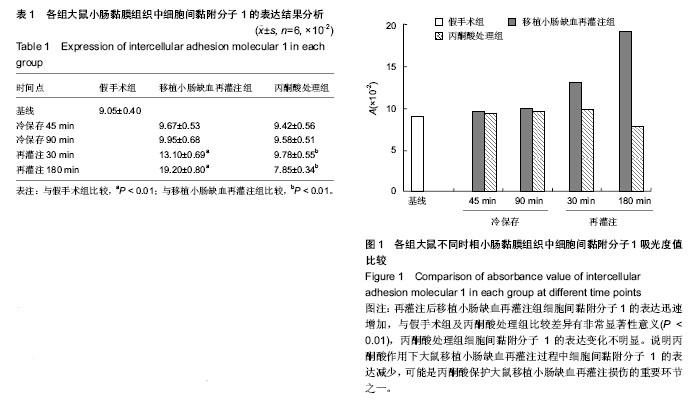| [1] 陆贝,蔡阳,封光华.细胞因子致鼠小肠移植中小肠缺血再灌注损伤及丹参保护作用的研究[J].医学研究杂志,2008,37(2):50-53.
[2] Guo J, Zhang J, Luo X,et al.Effects of ethyl pyruvate on cardiac function recovery and apoptosis reduction after global cold ischemia and reperfusion.Exp Ther Med. 2014;7(5): 1197-1202.
[3] Fink MP.The therapeutic potential of pyruvate.J Surg Res. 2010; 164(2):218-220.
[4] Caglayan EK, Caglayan K, Göcmen AY,et al.Protective effect of ethyl pyruvate on ischemia-reperfusion injury in rat ovary: biochemical and histopathological evaluation.Eur J Obstet Gynecol Reprod Biol. 2014;182C:154-159.
[5] Turkmen S, Mentese A, Karaguzel E,et al.A comparison of the effects of N-acetylcysteine and ethyl pyruvate on experimental testicular ischemia-reperfusion injury.Fertil Steril. 2012; 98(3):626-631.
[6] Karabeyo?lu M, Unal B, Bozkurt B,et al.The effect of ethyl pyruvate on oxidative stress in intestine and bacterial translocation after thermal injury.J Surg Res. 2008;144(1): 59-63.
[7] Sims CA, Wattanasirichaigoon S, Menconi MJ,et al.Ringer's ethyl pyruvate solution ameliorates ischemia/reperfusion- induced intestinal mucosal injury in rats.Crit Care Med. 2001; 29(8):1513-1518.
[8] Peltz M, Milchgrub S, Jessen ME, et al.Effect of pyruvate and HEPES on rat lung allograft acidosis and cell death after long-term hypothermic storage.Transplant Proc. 2010;42(7): 2771-2776.
[9] Peltz M, Hamilton TT, He TT, et al.Lung preservation solution substrate composition affects rat lung oxidative metabolism during hypothermic storage.Respir Physiol Neurobiol. 2005; 148(3):275-83.
[10] Petrat F, Rönn T, de Groot H.Protection by pyruvate infusion in a rat model of severe intestinal ischemia-reperfusion injury. J Surg Res. 2011;167(2):e93-e101.
[11] 韩鑫,肖福大,于明.丙酮酸在幼鼠肠缺血再灌注损伤中的作用[J].中华小儿外科杂志,2000,21(2):111-114.
[12] Gu Q, Yang XP, Bonde P,et al.Inhibition of TNF-alpha reduces myocardial injury and proinflammatory pathways following ischemia-reperfusion in the dog.J Cardiovasc Pharmacol. 2006;48(6):320-328.
[13] Fan H, Sun B, Gu Q,et al.Oxygen radicals trigger activation of NF-kappaB and AP-1 and upregulation of ICAM-1 in reperfused canine heart.Am J Physiol Heart Circ Physiol. 2002; 282(5):H1778-1786.
[14] Kobayashi A, Imamura H, Isobe M, et al.Mac-1 (CD11b/CD18) and intercellular adhesion molecule-1 in ischemia-reperfusion injury of rat liver.Am J Physiol Gastrointest Liver Physiol. 2001; 281(2):G577-585.
[15] Gu XP, Xu FT, Jiang Y, et al.Pyrrolidine dithiocarbamate added to University of Wisconsin solution inhibits reperfusion injury after orthotopic liver transplantation in rats.Ann Clin Lab Sci. 2004;34(2):187-194.
[16] Wang YH, Wang WY, Chang CC, et al.Taxifolin ameliorates cerebral ischemia-reperfusion injury in rats through its anti-oxidative effect and modulation of NF-kappa B activation. J Biomed Sci. 2006;13(1):127-141.
[17] Hou YC, Liou KT, Chern CM,et al. Preventive effect of silymarin in cerebral ischemia-reperfusion-induced brain injury in rats possibly through impairing NF-κB and STAT-1 activation.Phytomedicine. 2010; 17(12):963-973.
[18] Lu YT, Chen PG, Liu SF.Time course of lung ischemia- reperfusion-induced ICAM-1 expression and its role in ischemia-reperfusion lung injury.J Appl Physiol (1985). 2002; 93(2):620-628.
[19] Colletti LM, Cortis A, Lukacs N,et al. Tumor necrosis factor up-regulates intercellular adhesion molecule 1, which is important in the neutrophil-dependent lung and liver injury associated with hepatic ischemia and reperfusion in the rat.Shock. 1998; 10(3):182-191.
[20] Qiao X, Li RS, Li H, et al.Intermedin protects against renal ischemia-reperfusion injury by inhibition of oxidative stress.Am J Physiol Renal Physiol. 2013;304(1):F112-119.
[21] Zhao L, Peng DQ, Zhang J,et al.Extracellular signal-regulated kinase 1/2 activation is involved in intermedin1-53 attenuating myocardial oxidative stress injury induced by ischemia/ reperfusion.Peptides. 2012; 33(2):329-335.
[22] Chen FT, Yang CM, Yang CH.The protective effects of the proteasome inhibitor bortezomib (velcade) on ischemia- reperfusion injury in the rat retina.PLoS One. 2013;8(5): e64262.
[23] Sun MH, Pang JH, Chen SL, et al.Retinal protection from acute glaucoma-induced ischemia-reperfusion injury through pharmacologic induction of heme oxygenase-1.Invest Ophthalmol Vis Sci. 2010; 51(9):4798-4808.
[24] 郝志强,王为忠,李孟彬.丙酮酸作用下大鼠移植小肠缺血再灌注损伤中核转录因子的变化[J]中国组织工程研究与临床康复, 2008, 12(18):3406-3409.
[25] 郝志强,王为忠,李孟彬.丙酮酸对大鼠移植小肠缺血再灌注损伤的保护作用.[J]世界华人消化杂志,2005,13(2):265-267.
[26] Sozen B, Can A, Demir N.Cell fate regulation during preimplantation development: A view of adhesion-linked molecular interactions.Dev Biol. 2014;395(1):73-83.
[27] Azaouagh A, Churzidse S, Konorza T, et al.Arrhythmogenic right ventricular cardiomyopathy/dysplasia: a review and update.Clin Res Cardiol. 2011; 100(5):383-394.
[28] Wallander J, Holtz A, Larsson E,et al.Small-bowel transplantation in the rat with a nonsuture cuff technique. Technical and immunological considerations.Transpl Int. 1988; 1(3):135-139.
[29] Morrissey NJ, Blom D, Ryan CK, et al.Tolerance induction permits the development of graft-versus-host disease: donor-mediated attack following small bowel transplantation in mixed chimeras.Transpl Immunol. 1999; 7(1):19-25.
[30] Petersen SL.Alloreactivity as therapeutic principle in the treatment of hematologic malignancies. Studies of clinical and immunologic aspects of allogeneic hematopoietic cell transplantation with nonmyeloablative conditioning.Dan Med Bull. 2007; 54(2):112-139.
[31] Martinez-Mier G, Toledo-Pereyra LH, McDuffie JE, et al. P-selectin and chemokine response after liver ischemia and reperfusion.J Am Coll Surg. 2000;191(4):395-402.
[32] Martinez-Mier G, Toledo-Pereyra LH, McDuffie JE, et al. Exogenous nitric oxide downregulates MIP-2 and MIP-1alpha chemokines and MAPK p44/42 after ischemia and reperfusion of the rat kidney.J Invest Surg. 2002; 15(5): 287-296.
[33] Martinez-Mier G, Toledo-Pereyra LH, McDuffie E,et al. L-Selectin and chemokine response after liver ischemia and reperfusion.J Surg Res. 2000;93(1):156-162.
[34] Kobayashi A, Imamura H, Isobe M, et al.Mac-1 (CD11b/CD18) and intercellular adhesion molecule-1 in ischemia-reperfusion injury of rat liver.Am J Physiol Gastrointest Liver Physiol. 2001; 281(2):G577-585.
[35] Shang XZ, Issekutz AC.Contribution of CD11a/CD18, CD11b/CD18, ICAM-1 (CD54) and -2 (CD102) to human monocyte migration through endothelium and connective tissue fibroblast barriers.Eur J Immunol. 1998; 28(6): 1970-1979.
[36] Issekutz AC.Adhesion molecules mediating neutrophil migration to arthritis in vivo and across endothelium and connective tissue barriers in vitro.Inflamm Res. 1998; 47 Suppl 3:S123-132.
[37] Olanders K, Sun Z, Börjesson A, et al.The effect of intestinal ischemia and reperfusion injury on ICAM-1 expression, endothelial barrier function, neutrophil tissue influx, and protease inhibitor levels in rats.Shock. 2002;18(1):86-92. |

